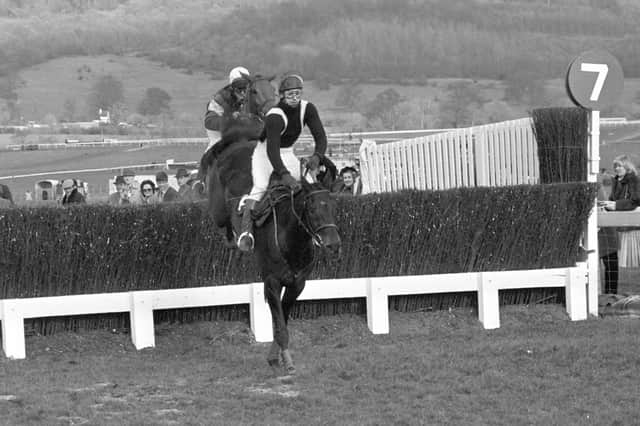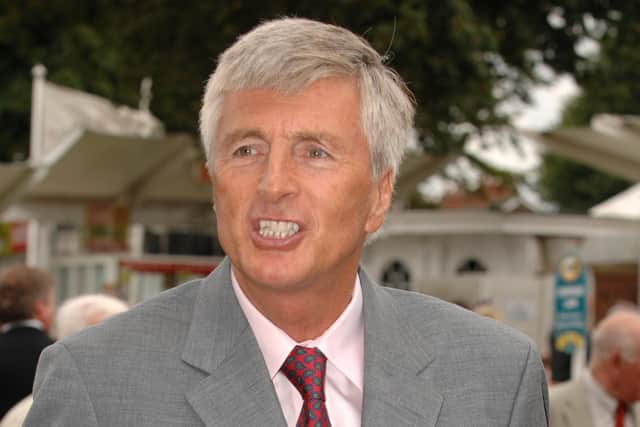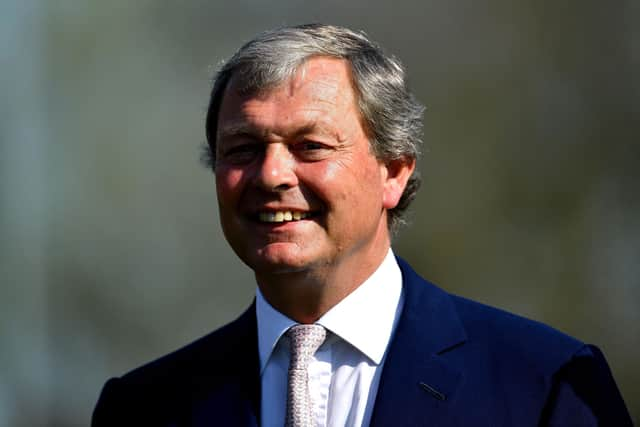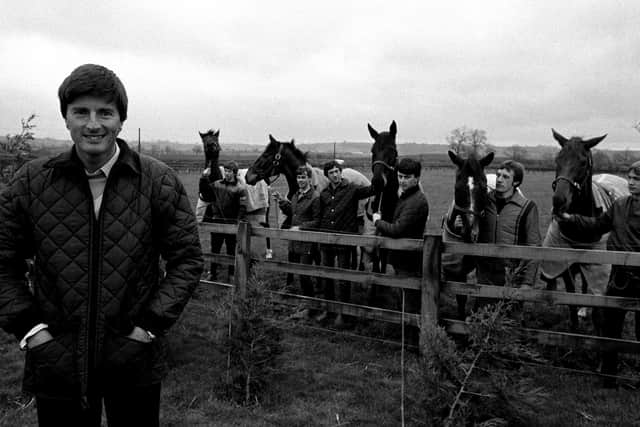How Silver Buck’s Gold Cup win for Michael Dickinson was inspired by Barney Curley’s ‘cloak and dagger’ Catterick gamble


Yet this remarkable horse, who could be spooked by his own shadow, was also the subject of a remarkable betting coup at Catterick that made his career.
He’d been spotted in point-to-point races in Ireland by the trainer and legendary gambler Barney Curley who sold Silver Buck to the Dickinson family in the summer of 1977 – Tony, Monica and their son Michael who would later rewrite racing’s record books.
Advertisement
Hide AdAdvertisement
Hide AdYet there was one caveat. “We bought Silver Buck off Barney on the condition that we would tell him when he would win his first race,” Dickinson told The Yorkshire Post ahead of this month’s Cheltenham anniversary,


However the near-black horse was of a nervous disposition – especially when riders were jumping on or off him – and he’d have to hack down the middle of roads, to the displeasure of motorists, because he was frightened of hedges.
But he showed sufficient promise in his racecourse debut at Carlisle to be entered in division two of the Brompton Amateur Riders’ Novices’ Hurdle at Catterick in December 1977.
And the conditions of the race meant that the ride was entrusted to Tom Tate, Michael Dickinson’s brother-in-law and later a successful trainer, as the call was made to Curley.
Advertisement
Hide AdAdvertisement
Hide Ad“I said to Barney ‘He’s a good horse, and has done one or two nice gallops. He will win provided he doesn’t do anything stupid’,” said Dickinson. “My instructions to Thomas (Tate) were simple – to come up the middle of the track to make sure the horse didn’t run out at any of the hurdles.”


The hot favourite was the Pat Rohan-trained Yellow Fire who had bolted up at Newcastle the previous week and the mount of the American amateur rider George Sloan. Yet few, other than the Dickinsons and the aforementioned Curley who died last May, knew about the 12-1 ‘dark horse’ in an era, long before mobile phones or the internet, when betting coups could be plotted with precision in secret.
By the start, Silver Buck was 5-1 after a sustained gamble orchestrated by Curley who was renowned for having teams of punters in place to target unsuspecting betting shops to secure the best odds.
Tate, who trains at Tadcaster with his wife Hazel, remembers it well. He had been told by Dickinson not to hit the front too soon on Silver Buck who was carrying 12st 7lb.
Advertisement
Hide AdAdvertisement
Hide AdBut the pacesetting Friendly Boy soon folded and left Tate’s mount in front before Yellow Fire took up the running in the home straight. However Silver Buck was travelling so well that he regained the lead on the gallop to the final flight – and it required all of Tate’s horsemanship to stop the horse ducking out and foiling Curley’s coup.


“It is one of my finest hours,” recalls Tate who would later train the likes of Ask Tom to Grade One success over jumps and Prince of Johanne to win a Royal Hunt Cup at Royal Ascot.
“Everyone knows about Barney now but, on that particular day, nobody knew and the horse ran in the colours of my mother-in-law Monica Dickinson. He was a horse that never won any race by much more than a length and a half. Once he hit the front, it was if he waited for the others.
“He was exceptionally talented. He wasn’t the biggest – but a magnificent jumper. In those days news didn’t travel so fast so our horse was 12-1. I do know what Barney (Curley) had on it but I won’t be revealing that. It was significant. A marvellous horse, a great privilege to ride and I will remember it to my dying day.”
Advertisement
Hide AdAdvertisement
Hide AdNow Curley was counting his winnings, the Dickinsons could find a suitable owner for Silver Buck and serendipity intervened in early 1978.
Existing owners with the Dickinsons included Christine Feather whose marriage to Brian Haggas had ended – their son William Haggas is the Classic-winning Flat trainer.
She was looking for a lift and was keen to purchase Cavity Hunter – she thought Silver Buck was “very moody and spooky”.
Yet, when owner Frank Tyldesley set his hearts on Cavity Hunter, Tony Hunter – Michael’s father – reportedly appealed to Feather’s better nature: “Would you be a real lady and have Silver Buck instead?” Her reply? “Tony, I’m so desperate for a horse I’ll have anything”. And that is how Silver Buck, in his predominantly black colours and red cap, finished fourth in the Sun Alliance Novices’ Hurdle at Cheltenham before going on to achieve much greater feats over larger obstacles.
Advertisement
Hide AdAdvertisement
Hide AdThese were to include back-to-back King George Chase wins at Kempton in 1979 and 1980, four successive wins in Haydock’s prestigious Edward Hanmer Chase – and a Gold Cup.
Third to Peter Easterby’s Little Owl and Night Nurse in the 1981 blue riband race – a one-two-three for Yorkshire – Silver Buck would beat stablemate Bregawn in 1982 on a memorable day for Dickinson who, by then, had moved the family’s stables from Gisburn to Harewood.
Silver Buck, the mount of Robert Earnshaw who is now a top steward, suffered a disrupted preparation to the 1983 Gold Cup when fourth to Bregawn in a race that saw Dickinson saddle the first five horses home – an unprecedented feat of training genius in any sphere of racing.
However Silver Buck brought great comfort to his late owner. “He was very good for my mother,” said the aforementioned Haggas. “She was going through a bad time personally and the horse gave her the confidence to go out again. In 1982, I was working for (Sir) Mark Prescott and he wouldn’t let me go (to Cheltenham). I watched the race at home. I was 22 then. I was pupil assistant – it’s just a glorified stable lad which is what I was. Silver Buck was a very good horse.”
Advertisement
Hide AdAdvertisement
Hide AdThis was self-evident in the 1982 Gold Cup when Earnshaw – lauded by Dickinson as “the best rider I have ever seen over a steeplechase fence” – bided his time on the first circuit in a race that attracted 22 runners.
The veteran 14-year-old Tied Cottage still led at the third last before Silver Buck took up the running – Earnshaw did not want to break the horse’s rhythm on such heavy ground.
They quickened away from the second last before shaving the top of the final fence to offer a glimmer to a young fresh-faced Graham Bradley on Bregawn.
Yet Silver Buck had enough in hand to win by just under two lengths in one of his most convincing wins. “You could never hit the front too soon on him,” added Dickinson.
Advertisement
Hide AdAdvertisement
Hide AdThe only alarm came in the winners’ enclosure when he briefly spooked – the 10-year-old stunned by the noise of the crowd’s reception.
It was a captivating contest enhanced by the climatic commentary of the BBC’s peerless Sir Peter O’Sullevan. Describing the race as “an astonishing finale...Silver Buck from Bregawn, the Michael Dickinson duo are going to finish one-two”, it was the prelude to a greater Gold Cup 12 months later.
Comment Guidelines
National World encourages reader discussion on our stories. User feedback, insights and back-and-forth exchanges add a rich layer of context to reporting. Please review our Community Guidelines before commenting.